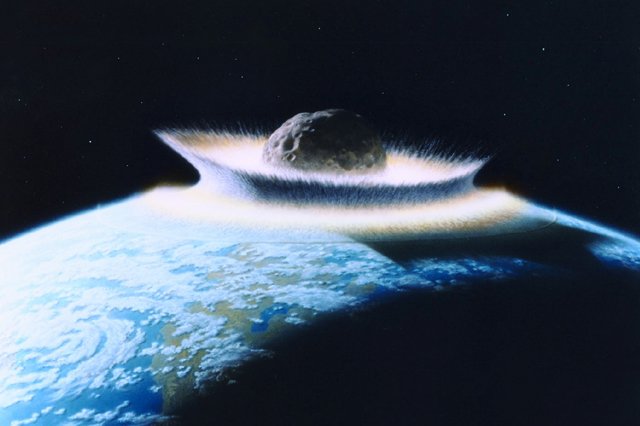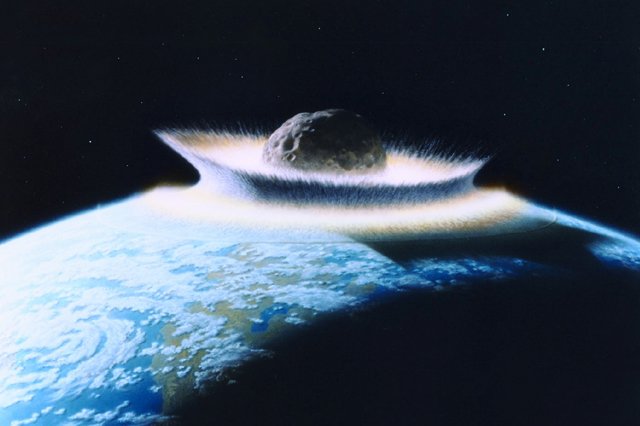NASA, FEMA, international partners to hold asteroid impact exercise
By Brooks Hays
April 24, 2019

Federal agencies and international partners will participate in a near-Earth object impact simulation, a "tabletop exercise," at the 2019 IAA Planetary Defense Conference. Photo by rw/D. Davis/NASA/UPI | License Photo
April 24 (UPI) -- NASA, FEMA and several other international partners will participate in an asteroid impact exercise at the 2019 Planetary Defense Conference.
As part of next week's "tabletop exercise," participants will respond to a fictional near-Earth object impact scenario.
"These exercises have really helped us in the planetary defense community to understand what our colleagues on the disaster management side need to know," Lindley Johnson, NASA's planetary defense officer, said in a news release. "This exercise will help us develop more effective communications with each other and with our governments."
During the exercise, participants will be briefed on the discovery of a fictional asteroid with a 1 in 100 chance -- the threshold of international action -- of impacting Earth in 2027. Participants will discuss potential responses, including deflection strategies. Participants will also plan mitigation efforts for the asteroid's potential impact.
NASA has previously participated in six different impact exercises, three of them with FEMA.
"What emergency managers want to know is when, where and how an asteroid would impact, and the type and extent of damage that could occur," said Leviticus Lewis, chief of FEMA's Response Operations Division.
Last year, NASA, FEMA, the Office of Science and Technology Policy and several other federal agencies collaborated on the production of "The National Near-Earth Object Preparedness Strategy and Action Plan," which outlined strategies for improving the government's ability to detect, predict, plan for and respond to a near-Earth object impact.
NASA is also working on improved algorithms, as well as the coordination of more powerful telescopes, in order to find and track the trajectories of potentially hazardous near-Earth objects. NASA scientists have also been developing computer models to simulate different types of impact scenarios.
Next week's exercise will offer NASA the chance to demonstrate the progress of their NEO impact preparedness efforts.
"NASA and FEMA will continue to conduct periodic exercises with a continually widening community of U.S. government agencies and international partners," said Johnson. "They are a great way for us to learn how to work together and meet each other's needs and the objectives laid out in the White House National NEO Preparedness Action Plan."

 www.upi.com
www.upi.com
By Brooks Hays
April 24, 2019

Federal agencies and international partners will participate in a near-Earth object impact simulation, a "tabletop exercise," at the 2019 IAA Planetary Defense Conference. Photo by rw/D. Davis/NASA/UPI | License Photo
April 24 (UPI) -- NASA, FEMA and several other international partners will participate in an asteroid impact exercise at the 2019 Planetary Defense Conference.
As part of next week's "tabletop exercise," participants will respond to a fictional near-Earth object impact scenario.
"These exercises have really helped us in the planetary defense community to understand what our colleagues on the disaster management side need to know," Lindley Johnson, NASA's planetary defense officer, said in a news release. "This exercise will help us develop more effective communications with each other and with our governments."
During the exercise, participants will be briefed on the discovery of a fictional asteroid with a 1 in 100 chance -- the threshold of international action -- of impacting Earth in 2027. Participants will discuss potential responses, including deflection strategies. Participants will also plan mitigation efforts for the asteroid's potential impact.
NASA has previously participated in six different impact exercises, three of them with FEMA.
"What emergency managers want to know is when, where and how an asteroid would impact, and the type and extent of damage that could occur," said Leviticus Lewis, chief of FEMA's Response Operations Division.
Last year, NASA, FEMA, the Office of Science and Technology Policy and several other federal agencies collaborated on the production of "The National Near-Earth Object Preparedness Strategy and Action Plan," which outlined strategies for improving the government's ability to detect, predict, plan for and respond to a near-Earth object impact.
NASA is also working on improved algorithms, as well as the coordination of more powerful telescopes, in order to find and track the trajectories of potentially hazardous near-Earth objects. NASA scientists have also been developing computer models to simulate different types of impact scenarios.
Next week's exercise will offer NASA the chance to demonstrate the progress of their NEO impact preparedness efforts.
"NASA and FEMA will continue to conduct periodic exercises with a continually widening community of U.S. government agencies and international partners," said Johnson. "They are a great way for us to learn how to work together and meet each other's needs and the objectives laid out in the White House National NEO Preparedness Action Plan."

NASA, FEMA, international partners to hold asteroid impact exercise - UPI.com
NASA, FEMA and several other international partners will participate in an asteroid impact exercise at the 2019 Planetary Defense Conference.
